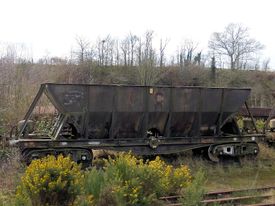ICI 19129 Bogie Steel Hopper Wagon
| ICI 19129 Bogie Steel Hopper Wagon | |
|---|---|
 ICI Bogie Steel Hopper Wagon 19129 | |
| Built By | Chas. Roberts, Wakefield |
| Status | Unrestored |
| Number | 3329 |
| Other Numbers | ICIM 19129, BR(M) 183566 (reg) |
| History | |
| Built | 1952 |
| Diagram | 6/486 |
| Type | Bogie steel hopper |
| Capacity | 48 tons |
| TOPS code | PHV, JGV after 1990 |
| Brakes | Vacuum fitted |
| 1994 | Arrived on the SVR |
It was given BR TOPS no. 19129 and BR registration no. 183566.[2] It had a capacity of 48 tons[3][4], although the SVR Stock Book and Stanier 8F Society give a capacity of 1,230 cubic feet equating to 43½ tons. The TOPS code for this class of wagon was originally PHV, recoded to JGV in 1990.[5]
Motive power used to haul these wagons would have included Stanier 8F locomotives. The wagon is one of two acquired by the Stanier 8F Locomotive Society, although there is no record that 48773 was used to haul ICI mineral traffic. It arrived on 7 May 1994 and was photographed in April 2015 stored on the Stourport Triangle.
Sister 19052 was cosmetically restored in November 2020 and the Society appealed for further funds to enable volunteers also to cosmetically restore 19129[1].
See also
References
- ↑ 1.0 1.1 8F Society Hopper Appeal Fundraiser page (Retrieved 27 October 2021)
- ↑ Stanier 8F Society
- ↑ Railway Heritage Register Wagon Survey
- ↑ Marsden (1984) p. 89.
- ↑ LTSV Wagons